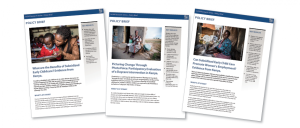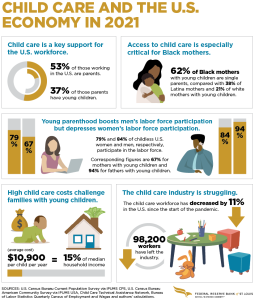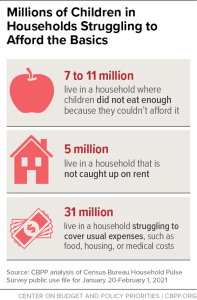6 Writing the Policy Brief: Structure & Content
Learning Objectives
Upon completion of this chapter, you will be able to:
- Identify and apply the key components of an effective policy brief.
- Develop skills in crafting a compelling narrative for a family policy brief.
- Apply strategies for presenting data and analysis clearly in a family policy brief.
- Collaborate with peers to develop a well-structured and compelling family policy brief that effectively communicates research findings, policy implications, and recommendations related to a specific family issue.
- Engage in constructive feedback and critique of policy briefs developed by peers, demonstrating an understanding of the key components, narrative techniques, and data presentation strategies discussed in the chapter.
- Understand and apply the concept of practical reasoning in the development of a family policy brief, ensuring that the proposed solutions are grounded in evidence, feasible, and aligned with the needs of families.
- Reflect on the process of crafting a family policy brief, identifying personal strengths, challenges, and areas for improvement in terms of structure, content, and persuasive writing.
6.1 Components of an Effective Policy Brief
Writing an effective family policy brief requires an approach that combines general policy brief writing guidelines with a focus on issues specifically affecting families. This type of brief aims to influence policy decisions by presenting research, evidence, and recommendations that address family welfare, support systems, childcare, eldercare, family rights, and other related social issues. Here’s a detailed guide on what is needed (FiscalNote, 2021):

- Understand Your Audience: Identify the key decision-makers, stakeholders, and influencers who can effect change in family policies. Understand their interests, priorities, and the political and social context in which they operate.
- Define the Issue Clearly: Articulate the specific family-related issue your policy brief aims to address. This could range from parental leave policies, childcare services, eldercare support, and family healthcare, to education and housing policies that affect family well-being. Provide a concise overview of the issue’s context, its impact on families, and why it is urgent or important.
- Incorporate Relevant Research and Evidence: Utilize current research, data, and case studies that highlight the issue’s impact on families and the effectiveness of proposed policy solutions. Ensure that the evidence and examples you include reflect the diversity of family structures and experiences.
- Policy Options and Recommendations: Present clear, actionable policy options that address the issue, including their potential benefits and drawbacks. Advocate for specific recommendations with a clear rationale for why they are the best course of action to support families effectively.
- Use Clear and Accessible Language: Avoid jargon by writing in clear, straightforward language to ensure the brief is accessible to policymakers, stakeholders, and the general public without specialized knowledge.
- Visuals and Design: Use charts, graphs, and infographics to illustrate key points, such as statistical trends affecting families or the comparative effectiveness of policy options. Ensure the document is well-organized and visually appealing, with a clear hierarchy of information that guides the reader through the brief.
- Conclusion and Call to Action: Briefly recap the issue, the evidence presented, and the recommended policy actions. End with a strong call to action, urging policymakers and stakeholders to take specific steps in support of the proposed family policy changes.
- References and Further Reading: List all sources of evidence used in the brief, ensuring they are reputable and up-to-date. This adds credibility to your arguments and allows readers to explore the topic further.
- Dissemination Strategy: Develop a strategy for getting your brief into the hands of key decision-makers and influencers in the family policy arena. Consider how you will follow up with stakeholders, including meetings, presentations, or media outreach, to discuss and advocate for your recommendations.
Writing an effective family policy brief requires a careful balance of persuasive argumentation, solid evidence, and a deep understanding of the policy landscape affecting families. By focusing on clarity, evidence, and actionable recommendations, you can craft a document that serves as a powerful tool for advocating family-focused policy changes. An example of an effective policy brief on Improving Access to High-Quality Affordable Childcare in Minnesota is located at https://files.americanexperiment.org/wp-content/uploads/2022/07/childcare-policy-briefing.pdf.
6.2 Crafting a Compelling Narrative
Crafting a compelling narrative for a family policy brief involves weaving together data, evidence, and personal stories to highlight the urgency of the issue and persuade stakeholders to take action. A well-constructed narrative can make the brief more engaging and memorable, ultimately driving home the impact of policy decisions on real families’ lives (Austin & Connell, 2019). Here are steps to craft such a narrative along with an example related to the issue of affordable childcare (Austin & Connell, 2019):
- Start with a Strong Opening: Humanize the issue by beginning with a story or anecdote that illustrates the real-world impact of the policy issue on families. This could be a composite or anonymized account based on real situations, designed to draw readers in and make the abstract issue feel personal and urgent. Here’s an example:
Maria, a single mother of two in Phoenix, Arizona, starts her day before sunrise. Each morning, she faces a tough decision: leave her children in a less-than-ideal childcare situation to go to work or miss a day’s wages to stay home with them. Like many parents, Maria’s choice is dictated by necessity, not preference. Her story is not unique; it’s a daily reality for millions of American families struggling to afford quality childcare.
- Define the Problem in Relatable Terms: Use clear, accessible language to explain the issue in terms that resonate with your audience’s values and concerns. Avoid jargon and technical language that might alienate non-expert readers. Also, link the specific family policy issue to broader themes or societal values, such as equality, economic security, health, or children’s well-being, to underline its significance. Here’s an example:
For countless families across the nation, affordable childcare remains an elusive pillar of support. The high cost of childcare services strains budgets, forcing parents to make impossible choices between their careers and their children’s welfare. This issue not only impacts family stability but also hampers economic productivity and the health of our communities.
- Present Data and Evidence as Part of the Story: Use data and research findings to bolster the personal stories you’ve shared, providing a solid evidence base that underscores the extent and seriousness of the issue. Highlight the impact on families by ensuring that the data you present specifically relates to the experiences of families, showing how policies directly affect their lives. Here’s an example, but be sure and include in-text citations for these data sources:
Recent studies show that the average cost of childcare in the United States consumes nearly 20% of a median family’s income, with figures soaring above 30% in major cities. Despite the critical role of childcare in enabling parents to work, federal investment in childcare assistance is significantly lower than that of other developed countries, leaving a gap that many families cannot afford to bridge on their own.
- Use Visuals to Enhance the Narrative: Visual aids can help to illustrate complex information, such as the demographic breakdown of affected families, trends over time, or comparisons between different policy outcomes. Also, make it personal by considering using photographs or illustrations that show real families or stylized representations to make the brief more visually engaging and emotionally impactful. Here’s an example:

An infographic highlights the disparity between the average cost of childcare and median family incomes across various states, illustrating the gap that policies must address. Another chart shows the correlation between access to affordable childcare and increased employment rates among parents, particularly mothers.
- Offer Solutions Through Storytelling: Describe how the recommended policy changes could transform the lives of families, using hypothetical but realistic examples to paint a picture of the positive outcomes that could result. If possible, incorporate quotes from experts, community leaders, or individuals directly affected by the policy issue to lend credibility and emotional weight to your recommendations. Here’s an example:
Imagine a future where Maria no longer faces her daily dilemma. With the introduction of a new subsidized childcare program, she can now leave her children in a high-quality childcare center, confident in their care and safety. This policy change not only transforms Maria’s life but also strengthens her entire community. Employment rates rise as parents re-enter the workforce, children benefit from early education programs, and the local economy thrives from increased participation.
- Conclude with a Call to Action: Wrap up the brief by reiterating the human element of the policy issue, reminding readers of the real-world stakes involved. End with a clear, compelling call to action that urges policymakers and stakeholders to implement the proposed changes, emphasizing the positive difference they could make in the lives of families. Here’s an example:
Maria’s story is just one of many that underline the urgent need for comprehensive childcare reform. It’s time for policymakers to act, to turn stories of struggle into narratives of empowerment and growth. By investing in affordable childcare, we can support working families, boost economic productivity, and lay a stronger foundation for future generations.
Our call to action is clear: Implement and expand subsidized childcare programs that ensure every family, regardless of income, has access to the quality care their children deserve.
- Revise for Clarity and Impact: Have others review the brief to ensure the narrative is clear, compelling, and logically structured. Ensure that the emotional appeal of your narrative is balanced with solid evidence and practical recommendations, to create a persuasive and credible document.
Crafting a compelling narrative requires balancing storytelling with factual evidence, making the policy issue at hand both relatable and urgent. By humanizing the issue, integrating data seamlessly into your narrative, and clearly outlining how proposed policies can make a tangible difference, you can create a powerful and persuasive family policy brief.
6.3 Presenting Data And Analysis Clearly
Presenting data and analysis clearly in a family policy brief is crucial for making a compelling argument that can influence policy decisions. The goal is to ensure that the evidence is accessible, understandable, and persuasive to a broad audience, including policymakers, stakeholders, and the general public. Here are key strategies to achieve this (Bardach & Patashnik, 2019; California Policy Lab, 2023):

- Start with a Clear Summary of Key Findings: Begin with an executive summary that highlights the main findings and recommendations. This should provide a clear, concise overview of the data and its implications for policy.
- Use Simple and Clear Language: Use straightforward language to explain data and analysis. When technical terms are unavoidable, include clear definitions. Always contextualize data to explain why it matters. For instance, if presenting data on the number of children without access to early childhood education, explain the potential long-term impacts on learning and development.
- Structure the Data Presentation Logically: Organize your data presentation to follow the narrative flow of the brief. Start with the most important information and follow with supporting data. Segment information by using headings and subheadings to break down the data into digestible sections. This helps guide the reader through your analysis step by step.
- Use Visuals to Illustrate Key Points: Utilize charts, graphs, and infographics to visualize data. This can make complex information more accessible and engaging. For example, bar charts can show comparisons between different groups, and line graphs can demonstrate trends over time. Every visual should have a clear caption and, if necessary, a brief explanation in the text to highlight what the reader should take away from it.
- Highlight Comparative Data: Whenever possible, compare the data to benchmarks, averages, or standards to provide context. For instance, comparing family income levels to the poverty line can help illustrate the extent of financial challenges faced by families.
- Offer Clear Interpretations and Recommendations: After presenting data, include a section that interprets what the data means for the issue at hand. Link back to the implications for families and policy recommendations. Ensure that your policy recommendations are directly supported by the data presented. Clearly outline how the data leads to each recommendation.
- Make it Accessible: Consider the accessibility of your document, including alternative text for visuals and a clear, easy-to-read font and layout. This ensures that the brief is usable by a wide audience, including those with visual impairments.
- Review and Feedback: Have colleagues or stakeholders review the data presentation for clarity and understandability. Feedback from individuals less familiar with the topic can be particularly valuable in identifying areas that may need further explanation.
Here’s an example:
- Imagine a policy brief focused on the need for increased access to affordable childcare. A compelling presentation of data might include:
- An infographic showing the percentage of families in different income brackets who spend over 20% of their income on childcare.
- A line graph depicting the increase in dual-income families over the past decade alongside the rising cost of childcare.
- A bar chart comparing childcare costs to average household expenses for necessities like housing, food, and healthcare.
By following these strategies, your family policy brief can present data and analysis in a way that is both clear and compelling, making a strong case for specific policy changes.
Policy Brief Project: Crafting and Advocating for Family Policy Change
Objectives: You will be able to apply the components of an effective policy brief; develop research, writing, and analytical skills within the context of family policy; and practice advocacy and presentation skills in a simulated policymaking environment.
This project is divided into three main phases: Research and Development, Writing the Policy Brief, and Advocacy Presentation. It can also serve as the final project as students are developing this brief over the entirety of the course.
Phase 1: Research and Development
- Topic Selection: Choose a specific family policy issue to address (e.g., affordable childcare, food insecurity, parental leave, housing affordability for families, etc.).
- Research: Conduct comprehensive research on your chosen issue, including its background, current policies, impacts on families, and potential policy solutions. Emphasis should be placed on finding credible sources and evidence to support your recommendations.
Phase 2: Writing the Policy Brief
- Outline Development: Students create an outline of their policy brief, organizing their research findings into a structured format that includes an executive summary, introduction, issue background, evidence and analysis, policy options and recommendations, and conclusion.
- Drafting: Using the outline, students draft their policy brief, ensuring they present their analysis and recommendations clearly and persuasively. Visual aids such as charts or graphs should be included to enhance the brief’s impact.
- Revision: Students revise their drafts based on peer or instructor feedback, focusing on clarity, coherence, and persuasive strength.
Phase 3: Advocacy Presentation
- Preparation: Prepare a presentation of your policy brief, summarizing key points and recommendations for a specific audience (e.g., mock policymakers, a community board).
- Presentation: In a simulated environment, present your policy brief, using persuasive techniques to advocate for their recommended policy changes.
- Q&A Session: After presentations, we will engage in a Q&A session, defending your recommendations and responding to questions or critiques from the audience.
Assessment: Students are evaluated based on several criteria:
- Research Quality: Depth and breadth of research, credibility of sources, and evidence used to support recommendations.
- Brief Quality: Clarity, organization, persuasiveness, and effectiveness of the policy brief, including the use of visuals.
- Presentation Skills: Ability to clearly and persuasively present the brief, respond to questions, and engage the audience.
Reflection:
After the presentations, conduct a reflection session where students discuss what they learned from the experience, the challenges they faced, and how they might approach policy advocacy in the future.
This activity not only enhances students’ understanding of family policy issues but also develops their skills in research, writing, and advocacy, preparing them for future roles in policy analysis, development, and advocacy.
References:
Austin, J., & Connell, E. (2019). Evaluating personal narrative storytelling for advocacy: A literature review prepared for living proof advocacy. Wilder Research. https://www.wilder.org/sites/default/files/imports/LivingProofAdvocacy_LiteratureReview_11-19.pdf
Bardach, E., & Patashnik, E. M. (2019). A practical guide for policy analysis: The eightfold path to more effective problem solving (6th edition). CQ Press.
California Policy Lab. (2023). Policy briefs 101: A guide for translating research findings into policy impact. https://www.capolicylab.org/wp-content/uploads/2023/05/Policy-Brief-Guide.pdf
FiscalNote. (2021). Your step-by-step guide to writing a winning policy brief. https://fiscalnote.com/blog/guide-writing-policy-brief

